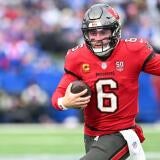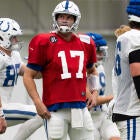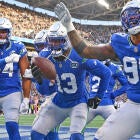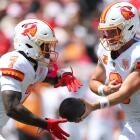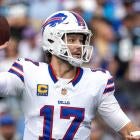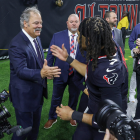Dan Quinn's Cowboys defense would be wise utilizing multiple looks in matchup against potent Chiefs
A patient approach by Patrick Mahomes and Co. would serve the Chiefs well

Over the last several weeks, the talk of the NFL has been the Kansas City Chiefs offense, and its relative struggles against two-high defenses. We took a different angle on what's been going on in Kansas City last week, focusing instead on the issues Travis Kelce had been having separating from man coverage.
Naturally, neither of those issues showed up all that much as the Chiefs got back on track against the Las Vegas Raiders on "Sunday Night Football." The Raiders use two-high safety looks less often than almost any team in the NFL, and did not use them very often against the Chiefs. They also did not play much man coverage, utilizing it for only seven snaps. Vegas spent most of the night in Cover-3, allowing the Chiefs to operate at a much higher level. (Kelce went off for 8 catches and 119 yards on 10 targets, while Patrick Mahomes threw for 406 yards and five touchdowns -- more scores than he had racked up in the previous four games combined.)
Raiders defensive coordinator Gus Bradley is a Pete Carroll acolyte, having been the Seahawks' defensive coordinator from 2009 through 2012. He's run that Carroll-style system in every subsequent stop, from Jacksonville to Los Angeles to Las Vegas. Bradley's successor in Seattle was none other than Dan Quinn, which is notable because after a stint as the head coach of the Atlanta Falcons, Quinn is now the defensive coordinator for Kansas City's next opponent: the Dallas Cowboys.
So, the Chiefs should expect to again see a ton of Cover-3, and continue tearing it up, right? Well, maybe not. Quinn has shown much more ability and willingness than Bradley to adapt to the times. As more and more teams have designed their offenses to beat the single-high safety defenses the Seahawks used to dominate the league in the early 2010s, Quinn has actually begun to change things up a bit.
TruMedia only has detailed coverage data for three of the five full seasons Quinn coached the Falcons (he was the coach from 2015 through the first five games of the 2020 season), but the way his coverage utilization has changed is stark.
In 2017, the Falcons were in Cover-3 on nearly 51% of opponent pass plays and Cover-1 on an additional 31%. All other coverages accounted for only 18% of passing plays. In 2018, Atlanta used 51% Cover-3 and 27% Cover-1.
Only in 2019 did Quinn begin to vary things a bit more, going with 38% Cover-3, 35% Cover-1, and 16% Cover-2. That trend continued into 2020, as his Falcons shifted to 32% Cover-3, 31% Cover-1, and 28% Cover-2 in the five games he coached before being fired.
This year's Cowboys defense is at 29% Cover-3, 32% Cover-1, 15% Cover-2, and 14% Cover-4. That is an even more dramatic shift away from what we'd come to expect from Quinn over the years.
For example, Quinn's 2017 through 2020 Atlanta teams never played Cover-4 on more than five snaps in a game. His Dallas defense has played more than five such snaps in four of their nine games so far. Quinn's Falcons had just two games (out of 53) where they utilized Cover-3 on less than 25% of opponent pass plays. His Cowboys have done so in four of nine games. Cover-3 was the most utilized coverage in 35 of Quinn's 53 games as coach of the Falcons from 2017 through 2020. That's a 66% share. It's been Dallas' most-utilized coverage in just three of nine games so far -- 33%.
That adaptability should serve the Cowboys well in their matchup with Kansas City this Sunday, but of course, what coverage is utilized after the snap is not the only thing that matters here. It's not as though the secret to defeating the Chiefs is just "play more Cover-2 and Cover-4." The Chiefs are indeed seeing more of those two-high coverages (36.4% of passing plays, per TruMedia) than the league-average team (27.2%), and they have not been as effective against them as they have against single-high looks. But the more exaggerated difference is in what Kansas City's offense is seeing pre-snap.
The Chiefs are seeing light boxes (six or fewer defenders close to the line of scrimmage) significantly more often than other teams in the NFL. Those looks encourage opposing offenses to run the ball by granting them a numbers advantage in the box. The bet is that they won't be patient enough to move the ball down the field in small chunks, and will instead try to force a pass deep down the field and into the waiting coverage. They can play two-high or one-high coverages out of the light box look by changing the picture post-snap.
It's worked quite well against Kansas City, which has seen a light box on 41.3% of snaps, compared with the NFL average of just 19.1%.
| Opponent | < 6 in Box | EPA/Play | 7+ in Box | EPA/Play | % 7+ in Box |
| CLE | 43 | 0.29 | 18 | 0.26 | 29.5% |
| BAL | 38 | 0.24 | 11 | 0.05 | 22.4% |
| LAC | 73 | 0.02 | 3 | 0.76 | 3.9% |
| PHI | 50 | 0.53 | 13 | 0.28 | 20.6% |
| BUF | 73 | -0.09 | 6 | -0.04 | 7.6% |
| WAS | 54 | 0.22 | 24 | -0.28 | 30.8% |
| TEN | 64 | -0.25 | 4 | 0.85 | 5.9% |
| NYG | 63 | -0.14 | 14 | 0.22 | 18.2% |
| GB | 44 | -0.31 | 19 | -0.13 | 30.2% |
| LV | 56 | 0.31 | 20 | 0.16 | 26.3% |
The impatience of the offense has been a big factor -- as have mistakes like drops and penalties. The Chiefs have committed a turnover on 18.4% of their drives, according to Pro-Football-Reference, the second-highest in the league behind only the Jets, who are only technically a real NFL football team. Mahomes had already had 10 passes intercepted this season -- two off his career-high mark, with seven games still left to play.
Being willing to take what the defense is giving will be especially key against the Cowboys. The Dallas defense -- led by NFL interception leader Trevon Diggs -- has forced a turnover on 16.3% of opponent possessions, the fourth-highest mark in the league. The Cowboys are extremely aggressive in attacking the football when it's in the air. They actually play a very similar style of defense to the Chiefs, counting on creating big plays to make up for a relative lack of high-level across-the-board talent. They've just done a much better job of it this season than the Chiefs have.
Working in Kansas City's favor here is that the Cowboys are down their two best pass-rushers. Demarcus Lawrence and Randy Gregory are each on injured reserve, leaving Dorance Armstrong, Tarell Basham, and Chauncey Golston as their primary edge defenders. Rookie linebacker Micah Parsons shifts to the edge situationally (and does so more often in some games than others) and could cause the Chiefs a lot of problems -- particularly if he lines up across from fill-in right tackle Andrew Wylie -- but the Chiefs can also cause plenty of problems for Dallas' coverage unit.
The Cowboys rank just 24th in Football Outsiders' DVOA on passes to opposing tight ends this season. Kelce has an advantage against whomever Dallas wants to line up against him, be it Jayron Kearse, Malik Hooker, Donovan Wilson, Damontae Kazee, Keanu Neal, Leighton Vander Esch, or Parsons. Tyreek Hill is a particularly bad matchup for Diggs, who does not have elite long speed and could thus struggle to keep up with the fastest receiver in football.
All of that is why it makes sense for Dallas to utilize heavy doses of the two-high looks against which the Chiefs have not been as effective. Cover-2 would allow the Cowboys to keep a safety over the top of any of Hill's routes from the perimeter. Cover-4 reduces the space over the middle for Kelce and allows a backside defender to cut off Hill's crossing routes. Of course, the Chiefs will have plenty of counters ready, if that's what Dallas elects to do. They just need those counters to be more effective than they have been in the recent past. It should be a fun chess match.






